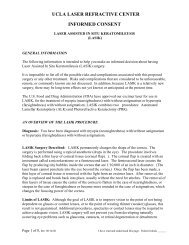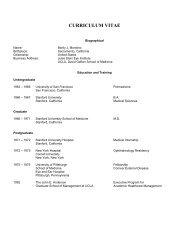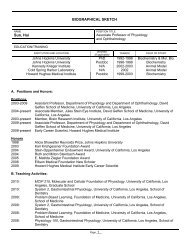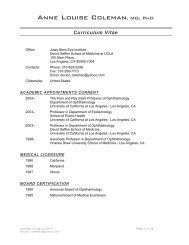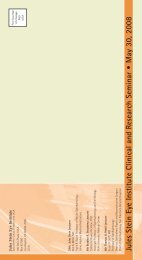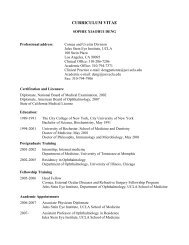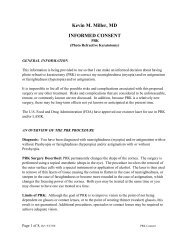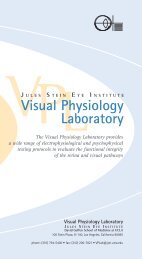View Annual Report - Jules Stein Eye Institute
View Annual Report - Jules Stein Eye Institute
View Annual Report - Jules Stein Eye Institute
You also want an ePaper? Increase the reach of your titles
YUMPU automatically turns print PDFs into web optimized ePapers that Google loves.
Research<br />
Research is a key component of the <strong>Institute</strong>’s<br />
mission and a high priority for faculty who often<br />
devote their life’s work to furthering our knowledge<br />
of specific vision processes and eye diseases.<br />
Major research grants are routinely awarded each<br />
year to support this effort. In 2011–2012, faculty<br />
members received important awards from both<br />
public and private organizations. New grants and<br />
grant renewals will enable faculty to further<br />
ongoing vision-science investigations that have<br />
shown promise and to undertake clinical trials that<br />
have direct application to some of the country’s<br />
most common ophthalmic problems.<br />
Drs. Kouros Nouri-Mahdavi and JoAnn Giaconi, along with other<br />
members of the Glaucoma Division, are leading the way in the study<br />
of sophisticated imaging tools that can be used to detect early signs<br />
of glaucoma-related damage.<br />
8 Highlights | Research<br />
Glaucoma Imaging Study<br />
Kouros Nouri-Mahdavi, MD, assistant professor of<br />
ophthalmology, is conducting research projects to<br />
investigate utility of different imaging techniques for<br />
improving detection of glaucoma or its progression.<br />
These studies aim to determine the performance of<br />
various testing modalities available on the newer<br />
spectral-domain optical coherence tomography<br />
(SD-OCT) for discrimination of glaucomatous eyes<br />
from normal eyes.<br />
Because of the higher resolution and the larger<br />
amount of data obtained by SD-OCTs, their use is<br />
expected to lead to better clinical performance and a<br />
higher rate of detection of early glaucoma or its<br />
progression. If the newer imaging devices are proven<br />
to have a better performance, they can potentially be<br />
useful for screening purposes and be especially<br />
valuable for evaluating cases that are suspected to<br />
show early glaucomatous damage where the visual<br />
field is frequently noncon-tributory. On the other end of<br />
the glaucoma spectrum, macular imaging is emerging<br />
as a promising modality for detection of progression in<br />
advanced glaucoma, since the retinal nerve fiber layer<br />
and optic nerve head in patients with advanced<br />
glaucoma are already too damaged to demonstrate any<br />
evidence of progression.




